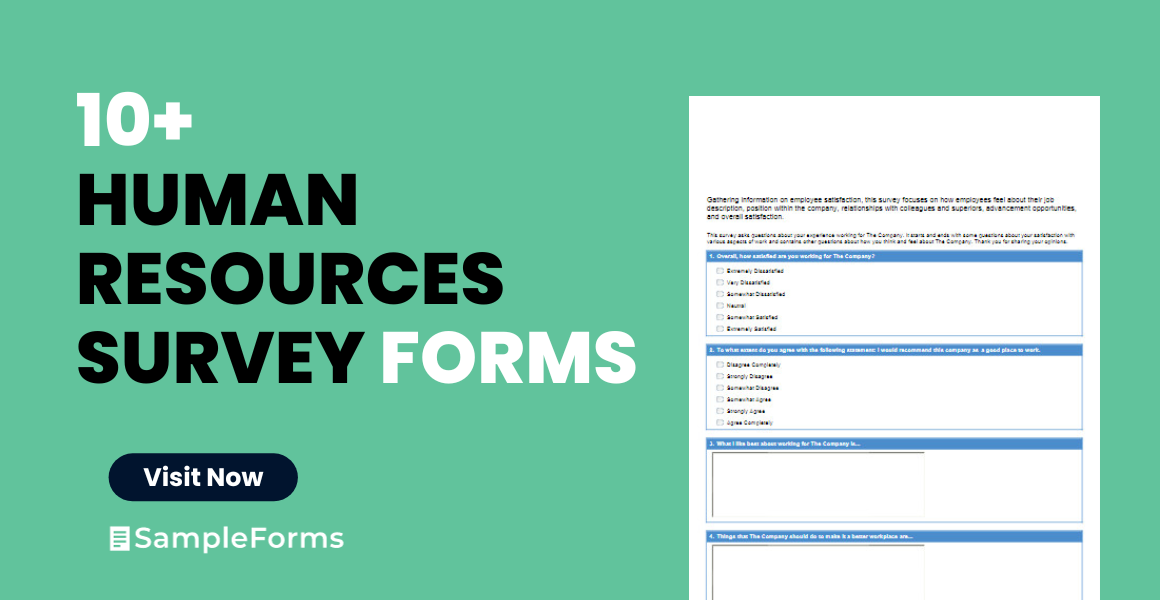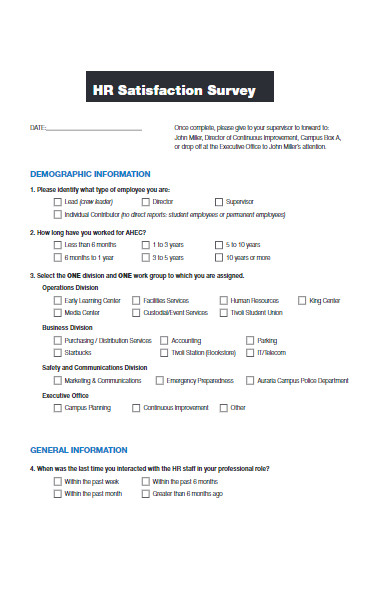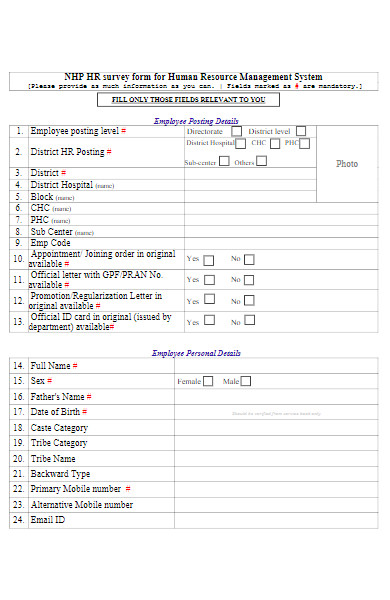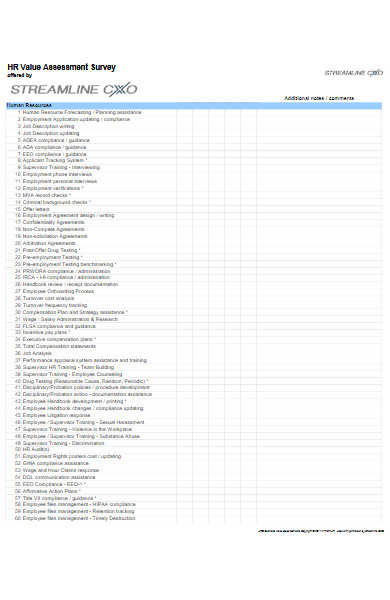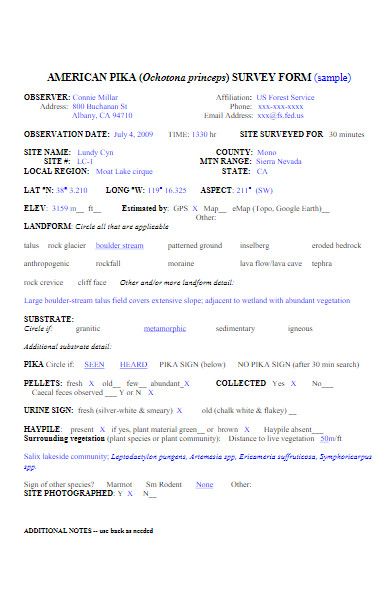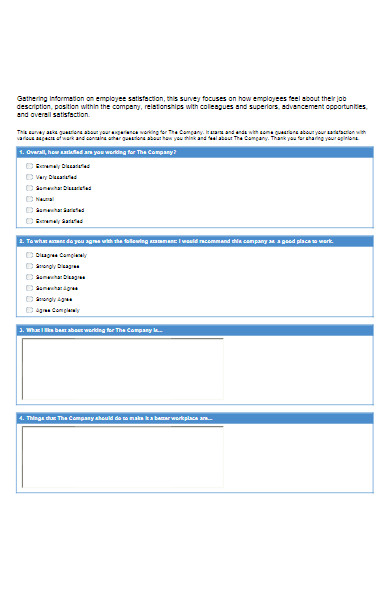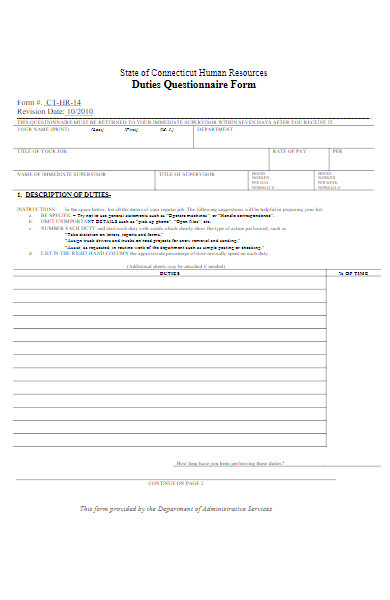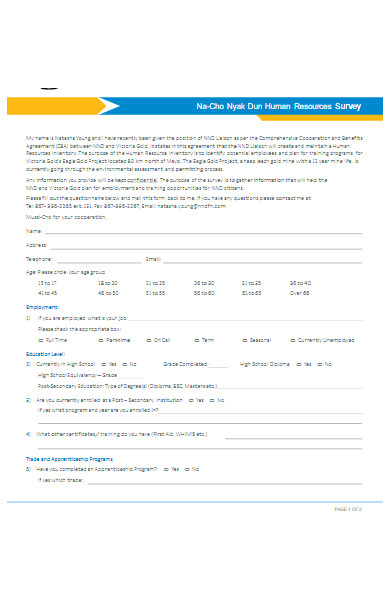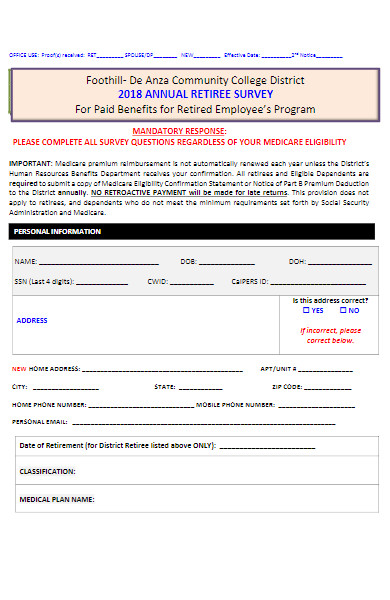A Human Resources Survey Form is an essential tool used by HR professionals to gauge employee satisfaction, workplace climate, and organizational effectiveness. These forms vary, encompassing employee engagement surveys, benefits satisfaction forms, and more. Effective survey forms are carefully designed to elicit honest, informative feedback that can drive meaningful workplace improvements. Tips for creating them include using clear, unbiased language, ensuring anonymity, and crafting questions that provide actionable insights. Properly executed, these surveys can be instrumental in fostering a positive and productive work environment.
What is a Human Resources Survey Form ? – Definition
A Human Resources Survey Form is a questionnaire designed to collect employees’ feedback on various aspects of their workplace experience. It’s used by HR departments to assess and improve areas like job satisfaction, employee engagement, understanding of company policies, effectiveness of training programs, and overall workplace culture. These feedback form is crucial for organizational growth, employee retention, and improving the work environment. Such forms can be used for anonymous feedback to ensure that employees feel comfortable sharing their honest opinions.
What is the Meaning of a Human Resources Survey Form?
The meaning of a Human Resources Survey Form lies in its role as a diagnostic tool that enables an organization’s HR department to collect valuable data on employee perceptions, morale, engagement, and satisfaction. It serves as a communication channel for employees to express their views on their work environment, management, and organizational practices. The insights gained from these printable form surveys are used to identify strengths and areas for improvement, fostering a responsive and employee-centric workplace culture that can lead to enhanced performance and job satisfaction.
What is the Best Sample Human Resources Survey Form?
The best sample for a Human Resources Survey Form would be one that effectively gathers the necessary insights while being easy to understand and respond to by employees. Here’s an outline for a general Employee Engagement Survey form, which is a common type of HR survey:
Employee Engagement Survey
Introduction: We value your candid feedback and understand that your responses are confidential. Please answer the following questions about your job and work environment.
Section 1: Job Satisfaction
- On a scale from 1 to 5, how satisfied are you with your job?
- What aspects of your job do you enjoy the most?
Section 2: Management and Leadership
3. How effective is the communication from management?
- Do you feel that your manager supports your professional development?
Section 3: Work Environment
5. How would you rate your work-life balance?
- Are you satisfied with the collaboration within your team?
Section 4: Training and Development
7. Have you received adequate training to perform your job effectively?
- Are there professional development opportunities available to you?
Section 5: Company Culture
9. Do you feel aligned with the company’s values and mission?
- How likely are you to recommend our company as a good place to work?
Section 6: Benefits and Compensation
11. Are you satisfied with your current compensation and benefits package?
- How could the company improve in this area?
Section 7: Feedback and Recognition
13. Do you feel recognized for your contributions at work?
- What can be improved regarding recognition and rewards?
Section 8: Overall Experience
15. Overall, how would you rate your employment experience with us?
Remember, this is a generic template and might need tailoring to better fit specific organizational contexts and goals. Additionally, anonymity should be ensured if sensitive data is being gathered to encourage honest and constructive feedback. You also browse our Sample Employee Survey Forms.
FREE 10+ Human Resources Survey Forms
11. New Employee HR Survey Form
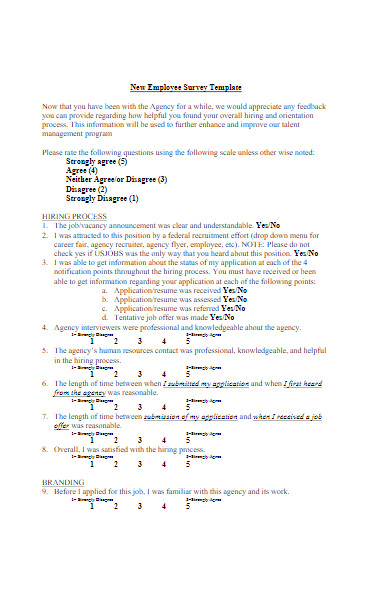
What is the purpose of Human Resources Survey Forms?
The purpose of Human Resources Survey Forms is multifaceted:
- Feedback Collection: They gather employees’ opinions and feedback on various aspects of their work life, from job satisfaction to workplace conditions.
- Assessment of Policies: They assess the effectiveness of HR policies and identify areas that need improvement.
- Employee Engagement: They measure employee engagement levels and identify factors contributing to or detracting from it.
- Training and Development Needs: They help determine the need for additional training and professional development opportunities.
- Organizational Climate Evaluation: They gauge the overall atmosphere and culture of the organization from the employees’ perspective.
- Decision Making: They provide data-driven insights that inform management decisions regarding HR strategies and workplace improvements.
- Performance Benchmarking: They can be used to benchmark organizational performance against industry standards or previous survey results.
- Retention Strategies: They help identify factors that can improve employee retention and reduce turnover rates.
Ultimately, these fillable forms are critical for continuous organizational improvement and for ensuring that the workforce remains motivated, satisfied, and productive.
How are the results of Human Resources Survey Forms used?
The results of Human Resources Survey Forms are used in several ways:
- Identifying Issues: To pinpoint areas of concern that might be impacting employee morale, productivity, or retention.
- Improving Policies: To inform and shape HR policies, ensuring they are aligned with employees’ needs and expectations.
- Enhancing Engagement: To develop strategies for increasing employee engagement and job satisfaction.
- Training Development: To identify gaps in training and development programs and create initiatives for professional growth.
- Performance Measurement: To measure the effectiveness of current HR initiatives and workplace practices.
- Cultural Insights: To gain insights into the organizational culture and identify steps to promote a positive work environment.
- Action Planning: To create action plans that address specific feedback from employees, demonstrating that their opinions are valued and acted upon.
- Benchmarking: To benchmark and track changes in employee sentiment over time, providing a metric for HR performance.
The goal is to use the data to make informed decisions that lead to tangible improvements within the organization.
How long does it take to complete Human Resources Survey Forms?
The time it takes to complete Human Resources Survey Forms sample can vary widely depending on their length and complexity. A brief survey might take only a few minutes, while a more comprehensive one could take up to 30 minutes or more. Typically, HR departments aim to design surveys that take 10-15 minutes to complete, respecting employees’ time while still gathering enough information to be useful. It’s often helpful if the estimated completion time is communicated to participants beforehand, so they can allocate sufficient time to provide thoughtful responses.
What types of questions are on Human Resources Survey Forms?
Human Resources Survey Forms can include a variety of question types, such as:
- Likert Scale Questions: These ask respondents to rate their agreement with a statement on a scale (e.g., Strongly Agree to Strongly Disagree).
- Open-Ended Questions: These allow employees to provide detailed responses in their own words, giving depth to their feedback.
- Multiple-Choice Questions: Employees choose from a list of predefined answers, which can simplify analysis.
- Ranking Questions: Respondents are asked to rank items in order of preference or importance.
- Yes/No Questions: Simple binary questions that can be quickly analyzed.
- Demographic Questions: These gather data on the composition of the workforce without compromising individual anonymity.
The questions are designed to elicit information on job satisfaction, engagement, understanding of company policies, workplace environment, management effectiveness, professional development opportunities, and other aspects of working at the company. You should also take a look at our HR forms.
How do I create effective Human Resources Survey Forms for employee feedback?
Creating effective Human Resources Survey Forms for employee feedback involves careful planning and design to ensure that the information gathered is relevant, actionable, and true to the employees’ sentiments. Here are steps and tips to guide you:
- Define Objectives: Clearly identify what you want to learn from the survey. Each question should serve a purpose and relate to your objectives.
- Keep It Concise: Limit the number of questions to avoid survey fatigue. A shorter, well-constructed survey often yields higher completion rates and more accurate responses.
- Use Clear Language: Write questions that are easy to understand, avoiding jargon or complex wording that might confuse respondents.
- Mix Question Types: Use a combination of multiple-choice, Likert scale, and open-ended questions to gather a range of data.
- Ensure Anonymity: If possible, make the survey anonymous to encourage honesty, ensuring employees that their responses cannot be traced back to them.
- Test the Survey: Pilot the survey with a small group to catch any confusing questions or technical issues.
- Communicate Purpose and Importance: Before distributing the survey, explain to employees why their feedback is valuable and how it will be used.
- Guarantee Confidentiality: Assure employees that their responses will be kept confidential and only used in aggregate form.
- Provide Instructions: Offer clear instructions on how to complete the survey and where to seek help if needed.
- Accessibility: Ensure the survey is accessible to all employees, including those with disabilities.
- Mobile-Friendly Design: If the survey is online, make sure it’s mobile-friendly to allow completion on various devices.
- Set a Deadline: Give a clear deadline for submission to create a sense of urgency and improve response rates.
- Follow-Up: Share the results and planned actions based on the survey to close the feedback loop and maintain trust in the process.
- Act on Feedback: Lastly, take concrete actions based on the survey results to demonstrate that you value and respond to employee feedback.
Can I see the collective results of Human Resources Survey Forms?
In many organizations, the collective results of Human Resources Survey Forms are shared with employees to maintain transparency and to show that the feedback has been taken seriously. Typically, this feedback is presented in an aggregated and anonymized format to protect individual privacy. Sharing the results can also help in driving organizational changes and ensuring that employees feel heard and valued. However, the extent to which the results are shared can vary by organization based on their policies and the nature of the survey. Our ….. is also worth a look at Sample Employer Survey Forms.
How to Create a Human Resources Survey Form?
Creating a Human Resources Survey Form involves several thoughtful steps to ensure it effectively captures employee feedback while being user-friendly. Here’s a step-by-step guide:
Step 1: Define Your Objectives
- Determine what you want to learn from the survey. Is it about job satisfaction, engagement, benefits, or workplace culture?
Step 2: Know Your Audience
- Understand who will be taking the survey. Consider language, tone, and cultural factors.
Step 3: Choose the Right Questions
- Decide on the types of questions that will best meet your objectives. Use a mix of Likert scale, open-ended, and multiple-choice questions.
Step 4: Write Clear, Concise Questions
- Ensure questions are straightforward and avoid leading or loaded questions that could bias responses.
Step 5: Design the Survey Layout
- Organize questions logically, grouping similar topics together. Make sure the layout is clean and uncluttered.
Step 6: Pilot the Survey
- Test the survey with a small group to identify any confusing questions or technical problems.
Step 7: Ensure Anonymity and Confidentiality
- If feedback is anonymous, communicate this clearly to encourage honest responses.
Step 8: Launch the Survey
- Roll out the survey to your target audience. Provide clear instructions and the purpose of the survey.
Step 9: Collect Responses
- Set a reasonable deadline for responses and send reminders as needed.
Step 10: Analyze the Data
- Review the responses, looking for trends, patterns, and areas needing attention.
Step 11: Report Back
- Share the results with management and, where appropriate, with employees.
Step 12: Take Action
- Develop an action plan based on the survey results and communicate this plan to the employees.
Step 13: Follow-Up
- Conduct follow-up surveys or sessions to measure progress and show commitment to continuous improvement.
Tips for creating an Effective Human Resources Survey Form
Creating an effective Human Resources Survey Form requires a balance of clarity, relevance, and engagement. Here are some tips to craft a survey that elicits valuable employee feedback:
- Be Clear and Specific: Use simple, straightforward language to avoid any ambiguity in questions.
- Keep It Relevant: Make sure each question is purposeful and relates to the objectives of the survey.
- Maintain Anonymity: Assure employees their responses are anonymous to encourage honest feedback.
- Limit Length: Keep the survey short and focused to respect participants’ time and prevent survey fatigue.
- Use Varied Question Types: Incorporate a mix of multiple-choice, Likert scales, and open-ended questions to gather a range of data.
- Pilot Test: Run a pilot survey with a small group to identify any confusing questions and technical glitches.
- Explain the Why: Communicate the importance of the survey and how the data will be used to improve the workplace.
- Ensure Accessibility: Design the survey to be accessible to all employees, including those with disabilities.
- Mobile Optimization: If online, ensure the survey is mobile-friendly for ease of completion on any device.
- Provide Instructions: Offer clear instructions and support for completing the survey.
- Set a Deadline: A clear deadline can help improve response rates.
- Offer Incentives: Consider offering incentives to encourage participation.
- Act on the Data: Follow up with action plans based on the survey results to show employees that their input leads to real change.
- Share Results: Where possible, share the general findings with employees to close the feedback loop.
- Regular Intervals: Conduct surveys at regular intervals to track progress and trends over time.
By following these tips, you create not just a blank form but a process that values employee input and contributes to a positive workplace culture.
A Human Resources Survey Form is a strategic tool used to capture employees’ feedback on their workplace experience, enabling HR to gauge satisfaction, engagement, and areas needing improvement. These forms come in various types, such as engagement or benefits surveys. Crafting them involves clear objectives, concise questions, and ensuring anonymity. Effective surveys can lead to actionable insights, fostering a responsive environment that values and acts upon employee feedback. You may also be interested to browse through our other Employee Benefits Survey Forms and HR Evaluation Forms.
Related Posts
FREE 10+ Sample Affirmative Action Forms in PDF MS Word
FREE 10+ Faculty Application Forms in PDF MS Word
FREE 3+ Employee Contact Forms in MS Word PDF
FREE 3+ HR Employee Concern Forms in PDF
FREE 10+ Sample HR Complaint Forms in MS Word PDF
FREE 8+ Sample Health Consent Forms in PDF MS Word
FREE 8+ Sample Job Questionnaire Forms in MS Word PDF
FREE 12+ Faculty and Staff Forms in PDF MS Word
FREE 31+ Needs Assessment Forms in PDF Excel | MS Word
FREE 5+ Employee Payroll Change Forms in PDF MS Word
FREE 9+ Sample Personnel Action Forms in MS Word PDF | Excel
FREE 53+ Human Resources Forms in PDF MS Word | Excel
FREE 40+ HR Forms in PDF
FREE 9+ Sample Employee Survey Forms in PDF MS Word | Excel
FREE 9+ Employer Survey Forms in PDF MS Word
